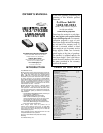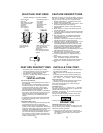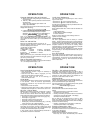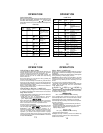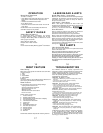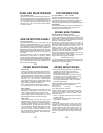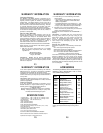
ARE DETECTORS LEGAL?
19 20
Radar Detector Detectors (VG-2)
The Interceptor VG-2, or simply VG-2, is a microwave
receiver used by police to detect signals radiated by the
local oscillator of a radar detector. Because its purpose is to
identify persons driving with radar detectors, the VG-2 is
known as a “radar detector detector”.
The VG-2 is the primary tool used by the police to
identify radar detector equipped vehicles. If caught, in a
state where detectors are illegal, (see page ??), drivers risk
losing their radar detector and receiving a fine. In
addition, instant-on radar is almost always used in
combination with a VG-2, leaving unsuspecting motorists
vulnerable to receiving two tickets - one potentially for
speeding, the other for possession of a detector.
Having a radar detector capable of detecting the VG-2 may
alert you to the presence of a speed trap.
For more information on speed monitoring technologies,
please visit our FAQ page on our website:
www.whistlergroup.com
It is the responsibility of the individual radar detector owner
to know and understand the laws in your area regarding the
legality of the use of radar detectors.
In Most States YES!
Laser/radar detectors are legal in every state (with the
exception of Virginia and Washington, D.C., which have
local regulations restricting the use of radar receivers in
any vehicle) when used in automobiles or light trucks
(under 10,000 lbs.). Similarly, when used in automobiles or
light trucks, radar detectors are legal in almost every state.
Exceptions are Virginia and Washington, D.C., which have
local regulations restricting the use of radar receivers in
any vehicle.
Concerning trucks over 10,000 lbs., the Federal Highway
Administration (FHwA) issued a regulation, effective
January, 1994 which prohibits radar and laser detector use
in these types of vehicles nationally. Prior to the FHwA reg-
ulation, laws existed in the state of New York restricting the
use of radar detectors in trucks over 18,000 lbs. and in
Illinois in trucks over 26,000 lbs.
SPEED MONITORING
FCC INFORMATION
FCC ID HSXWH11 - 1783, 1793SE
This device complies with part 15 of the FCC Rules.
Operation is subject to the following two condtions:
(1) This device many not cause harmful interference, and
(2) this device must accept any interference received,
including interference that may cause undesired operation.
IMPORTANT
FCC requirements state that changes or modifications not
expressly approved by Whistler could void the user’s
authority to operate the equipment.
CARE AND MAINTENANCE
Care And Maintenance
During the summer months, avoid prolonged exposure to
direct sunlight by removing your unit from the dash when
your vehicle is parked for an extended period of time. Do
not spray water, cleaners, or polishes directly onto the
unit. The spray may penetrate through the openings and
damage the unit. Also, do not use any abrasive cleaners
on the units exterior.
21
SPEED MONITORING
22
SPEED MONITORING
Radar Facts
A radar gun operates by transmitting radio waves at cer-
tain frequencies which reflect off objects and are then
picked up by the radar gun’s receiving section. When a
radar beam reflects off a moving target, a measurable
frequency shift occurs. The radar unit converts this shift
into miles per hour to determine your vehicle’s speed.
Currently, the FCC (Federal Communications
Commission) permits operation of traffic radar guns at X
Band (10.500 - 10.550 GHz), K Band (24.050 - 24.250
GHz), and Ka Band (33.400 - 36.000 GHz).
Note: A radar detector will not alarm if an officer is
not transmitting on any one of the above radar bands.
POP™ Mode
POP™ Mode operates within the normal K or Ka band
detectable by a radar detector. POP™ Mode in “POP
mode” allows the radar signal to travel from a radar
gun to a target in less than 1/10 of a second. A normal
detector without POP™ Mode detection can not see
this transmission because it transmits too quickly.
Laser Facts
It’s well documented that many radar guns cannot
reliably provide the speed of a targeted vehicle that is
traveling in a group of vehicles. In contrast, a laser gun
can target a specific vehicle out of a line of traffic and
determine its speed. The advantage of laser over radar
in terms of target identification is the result of the laser
gun’s narrow beam. A radar transmission can cover
more than a four-lane highway at a distance of 1,000
feet, compared with a laser transmission which covers
about 3 feet at the same distance. For best protection,
keep these points in mind:
• Because you vehicle’s license plate or headlights are
the laser gun’s primary targets, mounting your
Whistler detector on the dashboard can improve
laser detection at short range.
• Do not follow closely behind any vehicle you cannot
see through. If you can’t see past a vehicle ahead of
you, chances are your detector won’t either.
• The receiving range of your laser detector will not be
the same as a radar detector. Laser guns are most
often used at short range.
Whistler Laser/Radar detectors receive all current laser
guns which operate at a laser wavelength of
905 +/- 10mm.
•Pro Laser
™
I II III •LT1 20-20 •Ultra Lyte
Other Speed Detection Systems
Several techniques other than radar or laser are used to
measure vehicle speeds. When these methods are
being used, no detector can provide a warning. These
techniques include:
• Pacing - A patrol car drives behind you and matches
your driving speed.
• Vascar/Aircraft - The time it takes a vehicle to travel a
known distance is measured.
Laser Tips
If you are the targeted vehicle, a laser gun can often
determine your speed within a few seconds after you
receive an alert. In this situation there is generally no
time to safely adjust your speed. However, if you are
traveling near or behind the targeted vehicle and
receive an alert, response time should be sufficient. Any
laser alert, regardless of duration, requires immediate
action!



